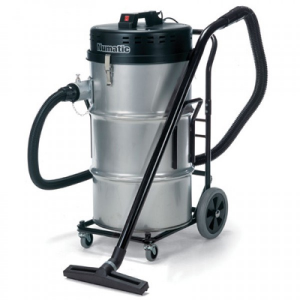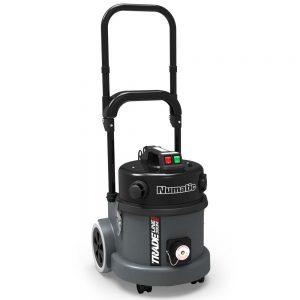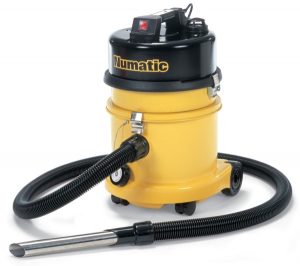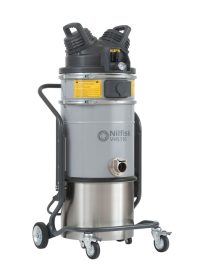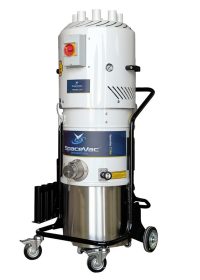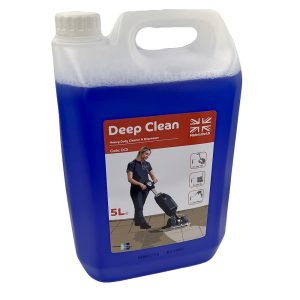An ATEX-rated vacuum cleaner is a specialized vacuum designed and certified to be used in environments where there is a risk of explosive atmospheres.
The term “ATEX” refers to the European Union directive that regulates equipment intended for use in potentially explosive atmospheres.
ATEX-rated vacuum cleaners are constructed to minimize the risk of sparks or other ignition sources that could potentially ignite flammable gases, vapours, or dust present in the environment. These vacuum cleaners adhere to specific safety standards outlined in the ATEX directive, ensuring they are suitable for use in hazardous locations such as chemical plants, petrochemical facilities, refineries, and other industrial settings where explosive atmospheres may be present.
Key features of ATEX-rated vacuum cleaners may include static dissipative materials, grounded components, and spark-resistant design to reduce the risk of ignition. These vacuum cleaners play a crucial role in maintaining a safe working environment in industries where explosive hazards are a concern by safely collecting and controlling potentially combustible materials.
We have a wide range of Specialist & Hazardous vacuums on our site, including ATEX machines. Here’s a brief overview of the different types of machines we offer…
Explosive Dust – ATEX
Sugar & flour – are classified as explosive dusts & can actually create an explosion if the wrong type of vacuum is used.
Years ago I went to a factory that made kitchen cabinets. The fine dust from the units was not collected properly & allowed to build up. The dust inside the machinery exploded, the dusty air in the factory ignited & the roof was literally blown off! It is only luck that no-one was killed.
This video explains it really well:
Industrial Vacuums
Industrial vacuums are powerful cleaning machines designed for heavy-duty cleaning tasks in industrial settings such as construction sites and manufacturing facilities. They are built to handle larger debris, dust, and potentially hazardous materials that typical household vacuums cannot.
Key Features:
Robust Suction Power: Industrial vacuums are equipped with powerful motors capable of handling large volumes of debris, including metal shavings, concrete dust, and more. 💪🔌
Durable Construction: These vacuums are built to withstand the rigours of industrial environments, often featuring sturdy metal or heavy-duty plastic construction. 🛠️🏗️
Large Capacity: Many industrial vacuums have sizable collection tanks or bags to minimize downtime caused by frequent emptying. 🚛🧼
Hazardous Vacuums
Hazardous vacuums are specialized machines designed for safely cleaning up and managing hazardous materials, including toxic dust, chemicals, and biological contaminants. They are used in environments where exposure to such materials could pose health risks. These are 2 main classifications M (medium risk) & H for high risk such asbestos.
Key Features:
Advanced Filtration: Hazardous vacuums employ advanced filtration systems, including HEPA (High-Efficiency Particulate Air) filters, to trap hazardous particles and prevent their release into the air. 🌬️🔒
Sealed Construction: These vacuums are often designed to be airtight, preventing any leakage of hazardous materials during operation or disposal. 🚫💨
Compliance with Safety Standards: Hazardous vacuums adhere to strict safety standards and regulations to protect both users and the environment. 🚧📜
M-Class H-Class & Explosive Dust Ratings: Managing Hazardous Dust 🌡️🧹
It’s important to note that businesses have a legal obligation to provide the appropriate vacuum to their staff. The classification of a vacuum is dependent on what they are picking up.
M-Class Rating (Medium Hazard):
The M-Class rating is associated with dust that poses a medium hazard to health.
M-Class vacuums are equipped with advanced filtration systems, typically including HEPA filters, to capture fine dust particles.
They are suitable for environments where exposure to dust like wood dust, plastics, and non-hazardous construction dust could pose health risks.
M-Class vacuums are used in woodworking shops, construction sites, and similar settings. Our most popular M Class vac is:
Many builders are reluctant to go to the expense of buying M-class vacuums as they are so used to using Henrys.
H-Class Rating (High Hazard):
The H-Class rating is assigned to vacuums designed for hazardous materials that pose a high risk to health, such as asbestos, lead, or carcinogenic dust.
H-Class vacuums offer the highest level of filtration and containment, ensuring that hazardous particles are safely captured and contained.
They are essential in industries like asbestos removal, lead paint abatement, and healthcare facilities where biological contaminants are present. ☢️🧼
In conclusion, industrial and hazardous vacuums are specialized tools tailored to the unique cleaning needs of industrial and hazardous environments. Their M-Class and H-Class ratings indicate their ability to safely manage hazardous materials, making them crucial for maintaining workplace safety and environmental compliance. 🌟🏭
You can find our range of specialist & hazardous vacuum cleaners here.
You can find our range of industrial vacuum cleaners here.
It’s important to note that these vacuums are for specialist applications & are, therefore, not always in stock. We can order them in pretty quickly, though. Just contact one of our specialists!
For more information on Dust Explosions, check out this website.
Any more questions? Be sure to check out our Getting To Know Vacuum Cleaners Blog.
====
Don’t forget to follow us on our socials for our latest updates:

